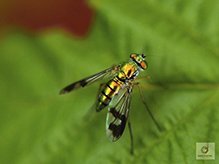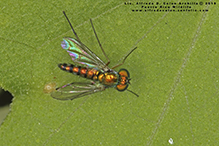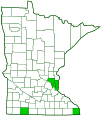longlegged fly
(Condylostylus sipho group)
Conservation • Description • Habitat • Biology • Distribution • Taxonomy
Conservation Status |
|
|||||||
| IUCN Red List | not listed |
|||||||
| NatureServe | not listed |
|||||||
| Minnesota | not listed |
|||||||
Description |
||
Condylostylus sipho is a species complex of six very similar longlegged flies. It is a small metallic green fly that occurs in the eastern United States and southeastern Canada. Adults are found in woodlands and meadows near streams and swamps. Adults prey on smaller insects. Larvae live in soil or under bark and are seldom seen. They prey on small invertebrates. Adults are slender and 3⁄16″ to ¼″ (5 to 6 mm) in length. The head, eyes, thorax, and abdomen are shiny and metallic green with a little to a lot of copper coloration. The head is broader than the thorax. There are two large compound eyes on the sides of the head and three small simple eyes (ocelli) in a triangle on top of the head. The compound eyes are bare, with no hairs. They do not meet at the top of the head on either sex. The antennae are black and short, shorter than the head. They have just three segments. The third segment is not ringed. There is a stiff, forward-pointing bristle (arista) on the upper side on the third segment. The arista is slender, very long, and bare, not feather-like (plumose). The combined protruding mouthparts (proboscis) is short and is modified for piercing. The thorax is large and has three segments. Each segment has four principal exoskeletal plates, one above, one below, and one on each side. The upper (dorsal) plates, from front to rear, are the prescutum, scutum, and scutellum. The prescutum and the scutum are not differentiated – there is no groove between them. There are two longitudinal rows of black bristles on each side near the middle. The outer (dorsocentral) row has 4 or 5 strong bristles. There are two pairs of bristles on the scutellum. Both pairs are long. The abdomen is long and tapered. On the male the genitalia are large, conspicuous, and folded under the abdomen. The wings have two smoky-brown bands on the outer half, connected along the leading edge (costal margin), forming a U shape. It may be dark and well-defined, or somewhat faded and broken. Sometimes it is reduced to cloudy areas along the veins. Sometimes it is too faint to be detected on photographs. The radial sector (Rs) vein has two branches and is slightly swollen at the fork. The M2 vein is present. The M1 is sharply recurved beyond the M2. The radial-media (r-m) cross vein, a short vein between the radius and media veins, is in the basal quarter of the wing. The legs are long. On both sexes, the third segment (femur) and fourth segment (tibia) of all legs are yellow. On the male the tibia of the middle leg has a row of bristles. The last part of the leg (tarsus), corresponding to the foot, has five segments. On the male, the first segment does not have a row of bristles. The six members of this species group are distinguished by the color of the first leg segment (coxa), and the presence or absence of bristles on the tibia and first tarsal segment on the middle leg. These features are not visible on most photographs. The description above refers to the nominate species, Condylostylus sipho. |
||
Size |
||
Total length: 3⁄16″ to ¼″ (5 to 6 mm) |
||
Similar Species |
||
Habitat |
||
Woodlands and meadows near streams and swamps |
||
Biology |
||
Season |
||
|
||
Behavior |
||
Adults perch on broad leaves. Males wave their front legs in courtship display. |
||
Life Cycle |
||
The larva pupates in the soil in a cocoon fashioned from soil. |
||
Larva Food |
||
|
||
Adult Food |
||
|
||
Distribution |
||||
|
Sources |
|||
| 8/9/2021 | ||||
Occurrence |
||||
Common |
||||
Taxonomy |
|||
Order |
Diptera (flies) | ||
Suborder |
Brachycera | ||
Infraorder |
Asilomorpha (Orthorrhapha) | ||
Superfamily |
Empidoidea (dance flies, long-legged flies, and allies) | ||
Family |
Dolichopodidae (long-legged flies) | ||
Subfamily |
Sciapodinae | ||
Tribe |
Sciapodini | ||
| Genus | Condylostylus | ||
Subordinate Taxa |
|||
longlegged fly (Condylostylus brimleyi) longlegged fly (Condylostylus furcatus) longlegged fly (Condylostylus longitalus) longlegged fly (Condylostylus scaber) longlegged fly (Condylostylus sipho) longlegged fly (Condylostylus viridicoxa) |
|||
Synonyms |
|||
Dolichopus sipho Psilopus gemmifer Psilopus scaber |
|||
Common Names |
|||
None of the more than 250 species in the genus Condylostylus has a common name. The common name for the family Dolichopodidae is longlegged flies, and it is applied here for convenience. |
|||
Glossary
Costal margin
The leading edge of the forewing of insects.
Femur
On insects and arachnids, the third, largest, most robust segment of the leg, coming immediately before the tibia. On humans, the thigh bone.
Ocellus
Simple eye; an eye with a single lens. Plural: ocelli.
Proboscis
The tube-like protruding mouthpart(s) of a sucking insect.
Scutellum
The exoskeletal plate covering the rearward (posterior) part of the middle segment of the thorax in some insects. In Coleoptera, Hemiptera, and Homoptera, the dorsal, often triangular plate behind the pronotum and between the bases of the front wings. In Diptera, the exoskeletal plate between the abdomen and the thorax.
Scutum
The forward (anterior) portion of the middle segment of the thorax (mesonotum) in insects and some arachnids.
Tarsus
On insects, the last two to five subdivisions of the leg, attached to the tibia; the foot. On spiders, the last segment of the leg. Plural: tarsi.
Tibia
The fourth segment of an insect leg, after the femur and before the tarsus (foot). The fifth segment of a spider leg or palp.
Visitor Photos |
|||||
Share your photo of this insect. |
|||||
| This button not working for you? Simply email us at info@MinnesotaSeasons.com. Attach one or more photos and, if you like, a caption. |
|||||
Mike Poeppe |
|||||
... after the rain today west of Houston, MN |
|||||
 |
|||||
Alfredo Colon |
|||||
 |
|||||
MinnesotaSeasons.com Photos |
|||||
|
|||||

Slideshows |
||

Visitor Videos |
|||
Share your video of this insect. |
|||
| This button not working for you? Simply email us at info@MinnesotaSeasons.com. Attach a video, a YouTube link, or a cloud storage link. |
|||
Other Videos |
|||


Created: 1/19/2021
Last Updated:


